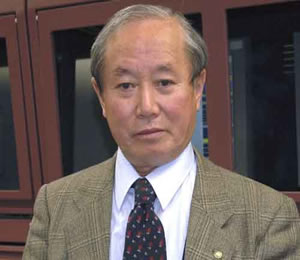
 |
'Climate skeptic' questions conventional thinkingMarch 26, 2007By Ned Rozell 
Syun-Ichi Akasofu. Photo by Jeff Pederson. "I always become suspicious when many scientists agree on some interpretation," he said. Now in retirement, the 76-year-old former director of both UAF's Geophysical Institute and International Arctic Research Center is digging in on a new idea that runs contrary to popular beliefs-that today's global warming might be more due to the planet's natural recovery from its last cold period than from our pumping of greenhouse gases into the air. Akasofu recently gave a talk at the International Arctic Research Center in which he presented evidence for how the world has warmed in a steady fashion from well before the Industrial Revolution to the current day. "If you look back far enough, we have a bunch of data that show that warming has gone on from the 1600s with an almost linear increase to the present," Akasofu said. He showed ice core data from the Russian Arctic that shows warming starting from the early 1700s, temperature records from England showing the same trend back to 1660, and ice breakup dates at Tallinn, Estonia, that show a general warming since the year 1500. Akasofu said scientists who support the manmade greenhouse gas theory disregard information from centuries ago when exploring the issue of global warming. Satellite images of sea ice in the Arctic Ocean have only been available in the satellite era since the 1960s and 1970s. "Young researchers are interested in satellite data, which became available after 1975," he said. "All the papers since (the advent of satellites) show warming. That's what I call 'instant climatology.' I'm trying to tell young scientists, 'You can't study climatology unless you look at a much longer time period.'" Melting glaciers, permafrost, and other signs of warming might be Earth's natural recovery from a period known as the Little Ice Age, Akasofu said. The Little Ice Age featured several centuries of very cold temperatures. The Thames River and New York Harbor often froze, and Vikings might have abandoned settlements at the time. Akasofu said there is no data that "most" of the present warming is due to the manmade greenhouse effect, as the members of the Intergovernmental Panel on Climate Change wrote in February. He pointed out that the atmosphere cooled from 1940 to 1975 despite a rapid increase in carbon dioxide emissions during the same period. "Nature changes all the time," he said. "The natural component is there. Until you remove it, you don't know the manmade effect." Akasofu said he could recall in the 1960s and 1970s when some scientists were talking about an approaching ice age. In the 1980s, global warming became a popular topic. "I think the initial motivation by the IPCC (established in 1988) was good; it was an attempt to promote this particular scientific field," he said. "But so many (scientists) jumped in, and the media is looking for a disaster story, and the whole thing got out of control." Akasofu said his tendency to go against the flow has been with him since he was a child in Japan. He looked beyond the accepted theory at the time to discover such things as the auroral substorm, the idea that the aurora explodes with activity more than once each night. In his career, he's seen many unconventional ideas become accepted theories. "Although the Anchorage Daily News called me 'Alaska's best-known climate-change skeptic,' I believe I am a critic," he said. "That is the only way science can advance." This column is provided as a public service by the Geophysical Institute, University of Alaska Fairbanks, in cooperation with the UAF research community. Ned Rozell is a science writer at the institute. |
|